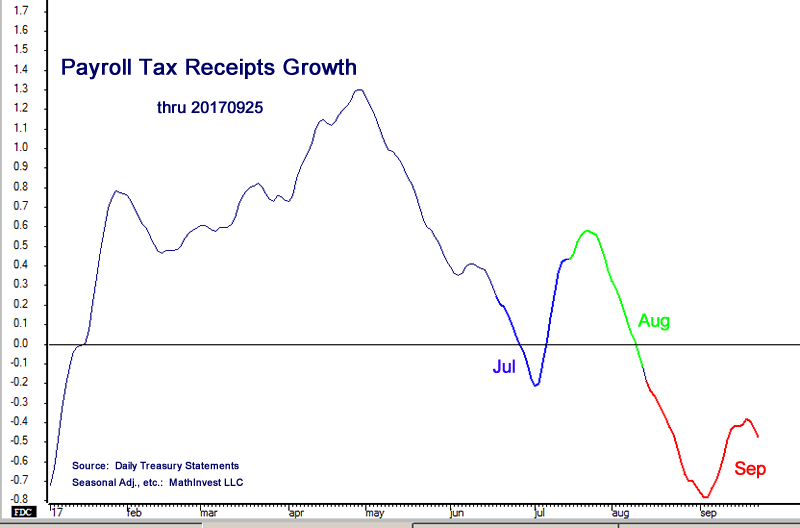The Amazon.com, Inc. (Nasdaq: AMZN) juggernaut has been and continues to be a disruptive force across a wide sector of the U.S. economy. Much of the financial news focuses on how Amazon’s growth may put traditional retailers out of business. The perception of massive e-commerce growth has hurt retail store and mall owning real estate investment trust (REIT) values. For the conservative income focused investor, a six stock REIT portfolio can be built to take advantage of the Amazon effect on the economy.
In spite of its two decades of rapid growth, as of mid-2017 Amazon had a 5% share of total retail sales, excluding food. In August, the company completed its acquisition of Whole Foods Markets, giving Amazon a foothold in the grocery sector. However, Whole Foods accounts for less than 2% of the grocery market. These facts lead to a pair of competing investment themes. First, with less than 5% of the total retail market, there is lots of room for Amazon to grow revenues. Second, the idea that more than 95% of retail sales happens away from the Amazon machine indicates that people still like to touch and feel before buying, that some types of retail are immune from e-commerce competition, and product companies want to have multiple outlets for the sales of those products.
Predicting the future is tough, and Amazon may succeed in taking over the world, but that is unlikely. Retail will evolve, and Amazon will be a major player and likely the biggest influence on that evolution. Let’s start two REITs each from three themes related to Amazon’s effect on the economy.
Theme #1: The financial news experts are wrong: brick-and-mortar retail will not be decimated. However, store based retail must evolve and adapt to a world of mixed direct and ecommerce sales. The one-sided reporting on this subject has led to a sell off retail property REITs and now the better companies are attractive value investments.
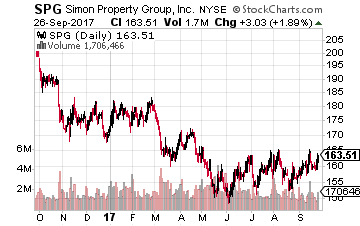 With a $50 billion market cap, Simon Property Group Inc (NYSE: SPG) is the largest publicly traded REIT. Simon owns and operates premium shopping and outlet malls. If a company needs to have retail stores, it wants to locate them in Simon run malls. The SPG dividend has been increased 15 times in the last five years, with the payout growing by 80%. This is a very successful mall operator. This stock is on sale, with a current share price down 30% from the July 2016 peak. Yield is 4.6%.
With a $50 billion market cap, Simon Property Group Inc (NYSE: SPG) is the largest publicly traded REIT. Simon owns and operates premium shopping and outlet malls. If a company needs to have retail stores, it wants to locate them in Simon run malls. The SPG dividend has been increased 15 times in the last five years, with the payout growing by 80%. This is a very successful mall operator. This stock is on sale, with a current share price down 30% from the July 2016 peak. Yield is 4.6%.- National Retail Properties, Inc. (NYSE: NNN) is a $6.1 billion market cap REIT that focuses on single tenant retail
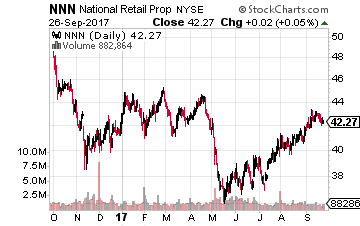 properties. The company owns over 2,500 stores, leased to 400 tenants operating in 40 different retail categories. Most of these categories are businesses which cannot be replaced by ecommerce alternatives. Business such as restaurants, health clubs, fuel and convenience stores and auto parts stores. National Retail Properties has increased its dividend for 28 Sconsecutive years. Dividend growth will be in a 3% to 5% annual range. NNN shares are down 19% since the 2016 high and yield 4.5%.
properties. The company owns over 2,500 stores, leased to 400 tenants operating in 40 different retail categories. Most of these categories are businesses which cannot be replaced by ecommerce alternatives. Business such as restaurants, health clubs, fuel and convenience stores and auto parts stores. National Retail Properties has increased its dividend for 28 Sconsecutive years. Dividend growth will be in a 3% to 5% annual range. NNN shares are down 19% since the 2016 high and yield 4.5%.
Theme #2: Most products sold by Amazon can’t be delivered over the Internet. Amazon’s business requires large amounts of warehouse space to fulfill and ship orders. Processing e-commerce orders takes up to three times as much warehouse space compared to the amounts needed by traditional retail for the same amount of product. Amazon possesses its own order fulfillment centers and also leases warehouse space. Companies that generate the other 50% of e-commerce sales also need warehouse space and services. These two REITs are the two largest Amazon landlords when it comes to owning large-scale fulfillment facilities.
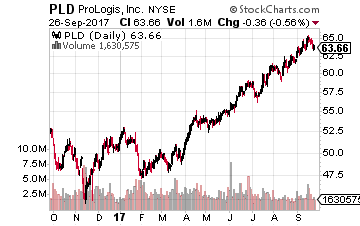 Prologis, Inc. (NYSE: PLD), with a $33 billion market cap, is a global logistics giant. The company owns or partially owns properties and development projects across 676 million square feet in 20 countries spanning four continents. Industrial/warehouse REITs are one of the hot REIT sectors. These companies can easily fill new projects and realize nice rental rate growth on existing properties. Prologis has increased its dividend by 50% over the last four years. The stock yields 3.4%.
Prologis, Inc. (NYSE: PLD), with a $33 billion market cap, is a global logistics giant. The company owns or partially owns properties and development projects across 676 million square feet in 20 countries spanning four continents. Industrial/warehouse REITs are one of the hot REIT sectors. These companies can easily fill new projects and realize nice rental rate growth on existing properties. Prologis has increased its dividend by 50% over the last four years. The stock yields 3.4%.- Duke Realty (NYSE: DRE) is an industrial REIT with a large US portfolio. Duke Realty is the largest,
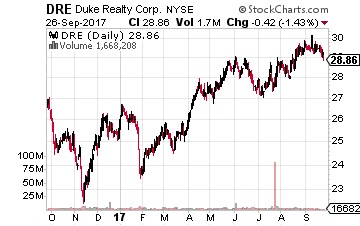 pure play, domestic only industrial REIT. The company owns 475 facilities in Tier 1 markets. Duke is highly focused on serving e-commerce sales and fulfillment. The company notes that projected e-commerce growth through 2020 will require almost 300 million square feet of additional industrial space. Amazon.com is Duke Realty’s largest tenant. The DRE dividends should grow by about 6% per year. The stock yields 2.6%.
pure play, domestic only industrial REIT. The company owns 475 facilities in Tier 1 markets. Duke is highly focused on serving e-commerce sales and fulfillment. The company notes that projected e-commerce growth through 2020 will require almost 300 million square feet of additional industrial space. Amazon.com is Duke Realty’s largest tenant. The DRE dividends should grow by about 6% per year. The stock yields 2.6%.
Theme #3: Growth in e-commerce means growth in Internet connectivity and data storage. Amazon Web Services is the company’s primary profit source. AWS is a secure cloud services platform, offering compute power, database storage, content delivery to help businesses scale and grow. Data center REITs are the high growth beneficiaries of the paradigm shift toward cloud computing and the trends toward distributed IT architecture, co-location and connectivity. Two data center REITs offer high-speed on-ramps to Amazon Web Services, including Direct Connect in many metros areas.
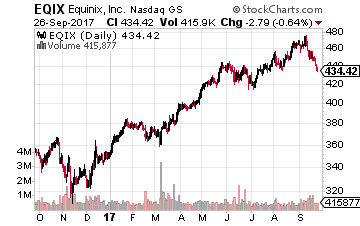 Equinix, Inc. (NASDAQ: EQIX) is a 19-year old S&P 500 company which became a REIT in 2015. Equinix owns and operates the largest global network of data centers, which focuses on connectivity and interconnection. The company’s revenues and EBITDA are growing at a high teens annual rate. AFFO (adjusted funds from operations) per share is increasing by over 20% per year. The dividend was increased by 14% this year. Equinix also has a history of paying large stock + cash special dividends. EQIX yields 1.8%.
Equinix, Inc. (NASDAQ: EQIX) is a 19-year old S&P 500 company which became a REIT in 2015. Equinix owns and operates the largest global network of data centers, which focuses on connectivity and interconnection. The company’s revenues and EBITDA are growing at a high teens annual rate. AFFO (adjusted funds from operations) per share is increasing by over 20% per year. The dividend was increased by 14% this year. Equinix also has a history of paying large stock + cash special dividends. EQIX yields 1.8%.- CoreSite Realty Corp. (NYSE: COR) focuses on
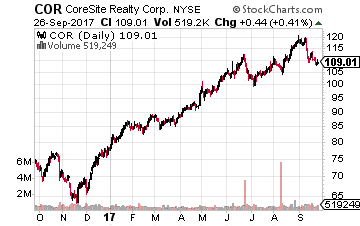 connectivity, primarily in eight major US markets. Here are the company’s amazing annual compound growth rates for the last six years.
connectivity, primarily in eight major US markets. Here are the company’s amazing annual compound growth rates for the last six years.
Revenue: 18%
Adjusted EBITDA: 26%
Funds from operations: 25%
Dividends: 35%.
This is outstanding growth from any type of business. COR yields 3.2%.
Companies able to adapt to changing economic and business environments – like Amazon encroaching on just about every business sector – are able to not only grow when everyone else is panicking but also reward investors. The six stocks above have a history of generously raising dividends so that for early investors their yield on cost can quickly become many times higher than the advertised regular rate.
Its high flyers and high-yield dividend stocks for income that constitute the core of the portfolio holdings in my Monthly Dividend Paycheck Calendar, a system used by thousands of income investors.
The Monthly Dividend Paycheck Calendar is set up to make sure you receive a minimum of 6 paychecks every month and in some months up to 14 paychecks from reliable high-yield stocks built to last a lifetime.
This unique tool will set you up to receive a more predictable dividend stock income stream that you can count on every month instead of just once a quarter like most other investors. Joining my calendar by Thursday, October 19th will give you the opportunity to claim an extra $1,820 in dividend payouts by October 27th.
The Calendar tells you when you need to own the stock, when to expect your next payout, and how much you can make from these low-risk, buy and hold stocks paying upwards of 12%, 13%, even 18%. I’ve done all the research and hard work, you just have to pick the stocks and how much you want to get paid.
Source: Investors Alley


